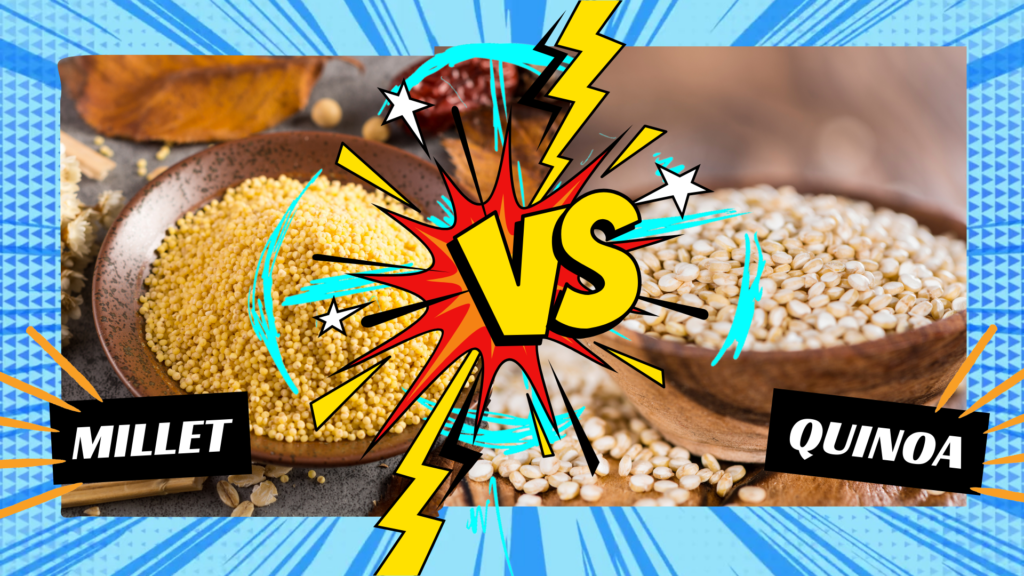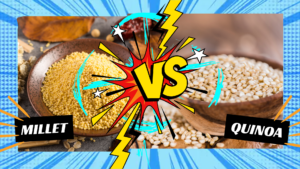

Millet vs. Quinoa: A Nutrient-Packed Showdown
In recent years, the health-conscious world has been buzzing about the nutritional benefits of ancient grains. Two such grains that have captured the spotlight are millet and quinoa. These small but mighty seeds have gained popularity for their impressive nutrient profiles and versatility in the kitchen. In this blog post, we’ll explore the differences and similarities between millet and quinoa and discuss why millets may have a slight edge over quinoa for certain dietary preferences and needs.
Millet: The Forgotten Super Grain
Millet is an ancient grain that has been a dietary staple in many parts of the world for thousands of years. There are various types of millet, including pearl millet, foxtail millet, finger millet (ragi), and more. Let’s delve into the merits of millet:
- Nutritional Powerhouse: Millet is a nutritional powerhouse. It’s rich in complex carbohydrates, dietary fibre, B vitamins (especially niacin and B6), magnesium, phosphorus, and iron. It also contains antioxidants, which help combat oxidative stress and inflammation.
- Gluten-Free: One of millet’s significant advantages is that it’s naturally gluten-free. This makes it an excellent choice for those with celiac disease or gluten sensitivity.
- Low Glycemic Index: Millet has a low glycemic index, meaning it doesn’t cause rapid spikes in blood sugar levels. This makes it suitable for people with diabetes or those looking to maintain stable energy levels.
- Digestibility: Millet is easily digestible and is gentle on the stomach, making it a good option for individuals with sensitive digestive systems.
- Versatility: Millet is incredibly versatile in the kitchen. It can be used in a wide range of dishes, from porridge to pilaf, and even as a base for gluten-free baking.
Quinoa: The Protein-Packed Sensation
Quinoa, often hailed as a superfood, is a grain native to South America, particularly the Andes region of Peru and Bolivia. It has gained worldwide popularity for its exceptional nutritional value and versatility. Here are some key aspects of quinoa:
- Complete Protein: Quinoa is renowned for being a complete protein source, as it contains all nine essential amino acids. This makes it an ideal choice for vegetarians and vegans who may struggle to obtain complete proteins from plant sources alone.
- Nutrient-Dense: Quinoa is loaded with nutrients, including fibre, vitamins (such as B vitamins, vitamin E, and folate), minerals (particularly magnesium, phosphorus, and iron), and antioxidants like quercetin and kaempferol.
- Gluten-Free: Like millet, quinoa is naturally gluten-free, which is advantageous for individuals with gluten-related health concerns.
- Quick Cooking: Quinoa cooks relatively quickly, usually in about 15-20 minutes, making it a convenient option for busy lifestyles.
- Versatile: Quinoa’s nutty flavour and slightly crunchy texture make it suitable for a wide range of dishes, including salads, stir-fries, soups, and even breakfast bowls.
Millets vs. Quinoa: A Comparative Analysis
Now, let’s compare millet and quinoa head-to-head:
- Protein Content: Quinoa takes the lead in terms of protein content, being a complete protein source with all essential amino acids. Millet contains protein too but doesn’t match the completeness of quinoa.
- Fibre Content: Millets outshine quinoa when it comes to dietary fibre. A higher intake of fibre aids digestion, helps in maintaining blood sugar levels, and promotes a feeling of fullness, aiding weight management.
- Nutrient Density: Quinoa is slightly more nutrient-dense, containing higher levels of vitamins and minerals, particularly magnesium and iron.
- Carbohydrates: Millet has a slightly lower carbohydrate content, which might be advantageous for individuals seeking lower-carb options.
- Taste and Texture: Millet offers a milder flavour and crumbly texture, while quinoa has a nuttier taste and a slightly crunchier texture.
- Cooking Time: Quinoa wins in terms of cooking speed, as it cooks faster than millet.
- Digestibility: Millet is generally easier to digest and may be gentler on the stomach, which can be crucial for those with digestive sensitivities.
Why Millets May Be Better for You
While both millet and quinoa have their unique strengths, there are compelling reasons why millets may be the better choice for certain individuals and dietary preferences:
- Digestive Sensitivity: Millet’s easy digestibility makes it a top pick for individuals with sensitive stomachs or digestive issues. If you’ve experienced digestive discomfort with other grains, millet might be a more gentle option.
- Low-Carb Diets: For those following a low-carb or keto diet, millet’s lower carbohydrate content makes it a suitable choice compared to quinoa.
- Blood Sugar Control: Millet’s low glycemic index can be advantageous for individuals looking to manage blood sugar levels or reduce the risk of diabetes.
- Milder Flavor: Millet’s milder flavour allows it to blend seamlessly into various recipes, absorbing the tastes of other ingredients without overpowering them.
- Affordability: Millet is often more affordable than quinoa, making it a budget-friendly option for health-conscious consumers.
-
Versatility and Resilience: Millets are also remarkably hardy and adapt to harsh, dry climates, making millets an ecologically friendly and more sustainable choice.
-
Not Just Another Grain: Millets have potential implications for addressing global nutrition security and health challenges, making them a pivotal player in sustainable farming and consumption.
In Conclusion
In the millet vs. quinoa debate, the choice ultimately comes down to your individual dietary needs, preferences, and health goals. While quinoa is indeed a nutritional powerhouse, millet holds its own with its unique advantages, especially in terms of digestive ease and lower carbohydrate content. Consider incorporating both grains into your diet to enjoy a diverse range of nutrients and flavours. Remember that a well-rounded diet should include a variety of grains, vegetables, and proteins to ensure optimal nutrition and overall health.

